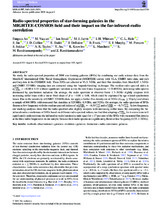| dc.contributor.author | Vacaari, M | |
| dc.contributor.author | An, Fangxia | |
| dc.contributor.author | Smail, Ian | |
| dc.date.accessioned | 2021-12-10T09:42:10Z | |
| dc.date.available | 2021-12-10T09:42:10Z | |
| dc.date.issued | 2021 | |
| dc.identifier.citation | An, F., Vaccari, M., Smail, I., Jarvis, M., Whittam, I., & Hale, C. et al. (2021). Radio spectral properties of star-forming galaxies in the MIGHTEE-COSMOS field and their impact on the far-infrared-radio correlation. Monthly Notices Of The Royal Astronomical Society, 507(2), 2643-2658. doi: 10.1093/mnras/stab2290 | en_US |
| dc.identifier.uri | https://doi.org/10.1093/mnras/stab2290 | |
| dc.identifier.uri | http://hdl.handle.net/10566/7066 | |
| dc.description.abstract | We study the radio spectral properties of 2094 star-forming galaxies (SFGs) by combining our early science data from theMeerKAT International GHz Tiered Extragalactic Exploration (MIGHTEE) survey with VLA, GMRT radio data, and richancillary data in the COSMOS field. These SFGs are selected at VLA 3 GHz, and their flux densities from MeerKAT 1.3 GHzand GMRT 325 MHz imaging data are extracted using the ‘superdeblending’ technique. The median radio spectral index isα3 GHz1.3 GHz=−0.80±0.01 without significant variation across the rest-frame frequencies∼1.3–10 GHz, indicating radio spectradominated by synchrotron radiation. On average, the radio spectrum at observer-frame 1.3–3 GHz slightly steepens withincreasing stellar mass with a linear fitted slope ofβ=−0.08±0.01, which could be explained by age-related synchrotronlosses. Due to the sensitivity of GMRT 325 MHz data, we apply a further flux density cut at 3 GHz (S3 GHz≥50μJy) and obtaina sample of 166 SFGs with measured flux densities at 325 MHz, 1.3 GHz, and 3 GHz. On average, the radio spectrum of SFGsflattens at low frequency with the median spectral indices ofα1.3 GHz325 MHz=−0.59+0.02−0.03andα3.0 GHz1.3 GHz=−0.74+0.01−0.02. At low frequency,our stacking analyses show that the radio spectrum also slightly steepens with increasing stellar mass. By comparing the far-infrared-radio correlations of SFGs based on different radio spectral indices, we find that adoptingα3 GHz1.3 GHzfork-corrections willsignificantly underestimate the infrared-to-radio luminosity ratio (qIR)for>17 per cent of the SFGs with measured flux densityat the three radio frequencies in our sample, because their radio spectra are significantly flatter at low frequency (0.33–1.3 GHz) | en_US |
| dc.language.iso | en | en_US |
| dc.publisher | Oxford University Press | en_US |
| dc.subject | Radio spectral properties | en_US |
| dc.subject | MeerKAT | en_US |
| dc.subject | COSMOS field | en_US |
| dc.title | Radio spectral properties of star-forming galaxies in the MIGHTEE-COSMOS field and their impact on the far-infrared-radio correlation | en_US |
| dc.type | Article | en_US |

